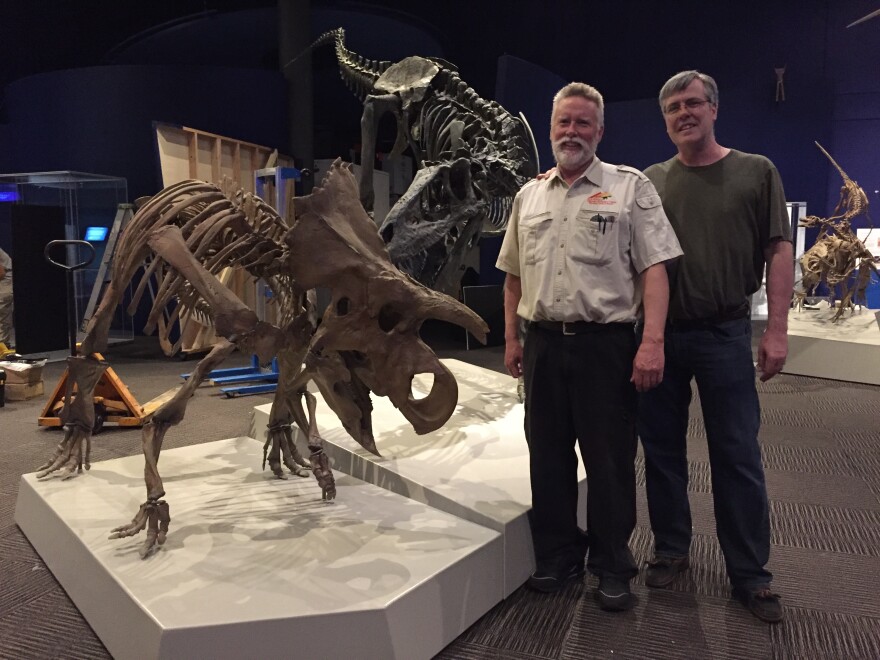When paleontologist Mike Triebold unearthed part of a dinosaur shoulder blade in Montana three years ago, he had no idea that he had stumbled upon a new species.
“When we collected it, we at first thought it was what is known as an Avaceratops, which is a known but rare Ceratopsian,” he said. “After we were working on it for a while, and began really thoroughly preparing the bones and analyzing them and comparing them, we realized, ‘Wait a minute. This is not an Avaceratops. It’s a brand new species.’ ”
This weekend, that dinosaur, dubbed “Ava," will be put on display at the Museum of Science and History as part of a new Darwin & Dinosaurs exhibit hosted at the museum for the duration of the summer. The exhibit will teach visitors about Charles Darwin and his Theory of Evolution, and how dinosaurs played an important part in this.
Avaceratops, the type of dinosaur most closely resembling Ava, looks very similar to the more well-known Triceratops, except for its missing nose horn. While the Avaceratops typically grew to around the same size as a Triceratops, Ava is likely a juvenile, according to Triebold. “It’s the size of a pony, but it has a really big head and horns,” he said.
“With new species that are discovered, the material is very sparse,” Triebold said. “But this particular animal is very unique in that we have about 85 percent of the skeleton complete, and the bones are in fabulous condition.”
The animal on display at MOSH is actually a cast of those original bones.
“If you’re mounting a skeleton of the original bones, you have to put all the armature (steel structure) on the outside of the bones,” Triebold said. “This is one of those odd cases where a cast of a skeleton is going to look more like the original skeleton than the original.”
But, there are actual dinosaur bones that visitors can touch. The bones are just one of the many components included in the exhibit.
“We built some interactives so you can explore the entire exhibition through images and videos and maps and widgets and quizzes and so forth on these large touch screens,” said Angus Carroll, co-curator of the exhibit.
Carroll is also the owner of what he says is one of the largest private Darwin collections in the world. The exhibit will contain first editions of several of Darwin’s books and papers, including “On the Origin of Species."
Carroll says that Darwin and dinosaurs are related in a straightforward way. The discovery of dinosaurs led to the concept of extinction, which led researchers of the early 1800s to question how they traditionally thought about creation.
“The dinosaurs and the early geological discoveries played a very important role in setting the stage for Charles Darwin," he said. "Had he gone earlier, it’s unlikely he would have come to the same conclusions.”
Because Darwin’s discoveries call into question many religions’ creation stories, they have been controversial from the time of their first publication. Carroll, however, says he doesn’t see it that way.
“We include things in the exhibit from famous people who specifically say they see no contradiction between modern evolutionary theory and religious beliefs,” he said. “That’s certainly our position. It’s not an either-or: they’re two different fields.”
At the very least, Carroll hopes that the exhibit will offer visitors the chance to learn something new.
Triebold’s own fascination with fossils started with a visit to a museum. As a boy growing up on a farm in North Dakota, Triebold and his brothers had to prepare the fields by manually clearing them of rocks.
“It was hard work, but it was also really boring work,” he said. “So I started looking at the rocks.”
When he was 5 years old, his parents took him to the School of Mines Museum in Rapid City, South Dakota.
“I looked a mosasaur in the eye, and I had no idea what this giant creature was,” he said. “My dad explained to me about extinction.”
Triebold’s and Carroll’s tour will offer that same chance for visitors.
“That’s what scientific inquiry is all about," he said. "If you have a question, there very well may be an answer somewhere, but you need to go look for it. And looking for the answers is half the fun.”

